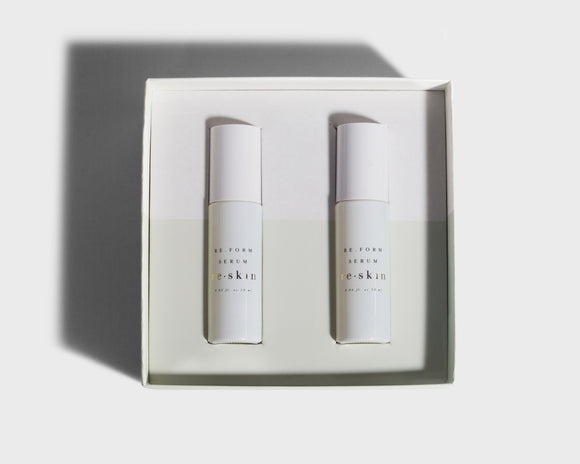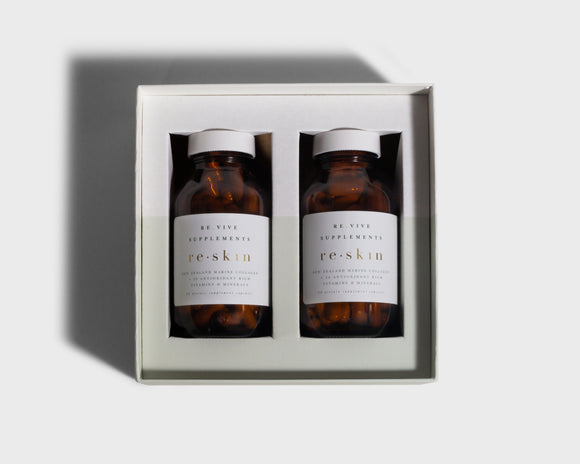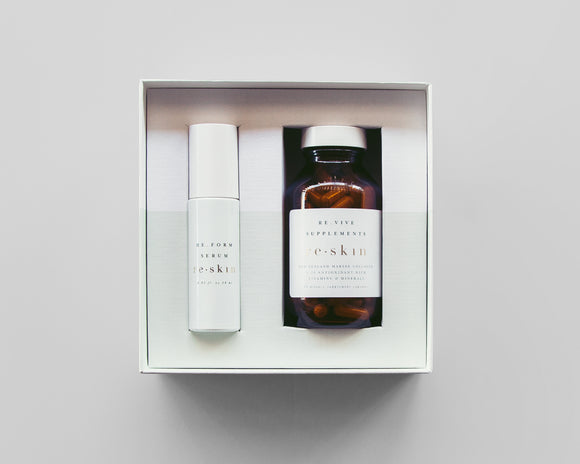
Here at re.skin our holistic approach to skin means we believe what you put in is just as important as what you put on.
Great skin is built on these fundamental basics:
1. Simple skincare solutions with no nasties
2. An internal supplement for optimum skin health
3. A balanced, healthy diet
The link between diet and skin
The foods you fuel your body with can either promote glowing skin or negatively affect its appearance. If you need convincing, the only proof you need that there’s a direct correlation between skin and diet is staring back at you in the mirror after a sugar laden weekend.
How long does it take for diet to show in the skin?
According to Food Coach NYC diet can show up in the skin from as little as two hours after consumption if you have undetected food sensitivity like gluten or dairy. While fried foods, sugar and alcohol generally surfaces within 12 hours.
To help you on your journey to complexion perfection, we’ve collated a list of the foods to steer clear of below.
The worst foods for your skin
Sugar
Surprise, surprise…sugar is not your skin’s friend. Foods rich in sugar, particularly of the refined variety, cause the body's insulin levels to spike and can result in skin inflammation. But it’s not just your waistline affected – if you’re chasing the fountain of youth be warned: regular consumption of sugar breaks down collagen and elastin, which can lead to crow’s feet and fine lines. Collagen is also the natural protein that promotes plump and supple skin so retaining as much as possible is key for a youthful glow.
Salt
The white stuff isn’t the right stuff to keep wrinkles at bay. The maximum daily amount of salt recommended for adult New Zealanders is about 6g (2300mg sodium). That's about 1 teaspoon from all food sources. Any more than the daily recommendation can lead to high blood pressure, which can weaken the skin by affecting collagen networks. Diets high in sodium will be more prone to wrinkles, especially in thin-skinned areas like around your eyes.
High glycemic foods
You know those fries you ate over lunch? They’ll probably show up on your face too. Foods with a high glycemic index (GI) trigger blood sugar levels to rise at a rapid rate, giving you a sugar rush. A food's GI indicates the rate at which the carbohydrate in that food is broken down into glucose and absorbed from the gut into the blood. Foods with a high GI, 70 or higher, can cause inflammation in the skin which can lead to breakouts. Starchy foods such as white bread, pasta and cake are considered high glycemic and can exasperate skin conditions like acne and eczema. Even worse are fried carbohydrates as they alter the cell membrane structure, making it harder for skin cells to eliminate waste. If you're unsure of a food's glycemic level, consult the glycemic index (GI) – carbohydrates with a ranking of 55 or less are considered low GI and cause a lower and slower rise in blood glucose.
Spicy food
While not a trigger for everyone, spicy foods are a common skin sensitivity. Spicy food generates heat (obviously) so naturally it can lead to inflammation or redness in the skin. Those sensitive to spicy foods will find their blood vessels in the skin dilate, making their skin flare-up, flush and rise in temperature. Broken capillaries are also a common sign of a diet high in spice. There are obvious offenders like curry and hot sauce but watch out for less evident offenders like tomato and barbecue sauce, mustard, red capsicum and vinegar.
Alcohol
A few cocktails later and you may be *happy and you know it* but your skin won’t be. If your skin is on the sensitive side you might even noticed the effects immediately: redness, blotchiness and hot to touch. It’s important to re-hydrate after drinking alcohol - and not just a few glasses when you get home, you need to consistently hydrate the next day too.
Dairy
Arguably skin’s worst enemy is dairy. Dairy is one of the most prominent skin aggravators, changing how testosterone and oestrogen is regulated in the body. Dairy is also often full of skin-disrupting hormones that can further imbalance your own. Try to cut down on milk, cheese, yoghurt and ice cream.
“Anti-Ageing Foods”
Thankfully there is good news when it comes to diet too. While your food choices could be wreaking havoc on your skin, the right foods could help revive it! According to new research, certain foods can help slow down the ageing process and restore that coveted youthful glow. One health and wellness expert, Dr Vincent Candrawinata, says this is because certain foods assist in the rejuvenation of our cells – and that includes skin cells.
Vitamin and mineral rich foods: fruits and vegetables like spinach, broccoli, pineapple and watermelon are rich in essential in essential nutrients.
Healthy fats: Nuts, avocado and coconut oil are all good fats brimming with anti-inflammatory omega-3’s, which can help to ward of signs of ageing.
Protein: Protein-rich foods will boost collagen production and keep skin firm and smooth. Red meat, fish and eggs are great sources of protein while tofu and legumes are best for plant-based diets.



